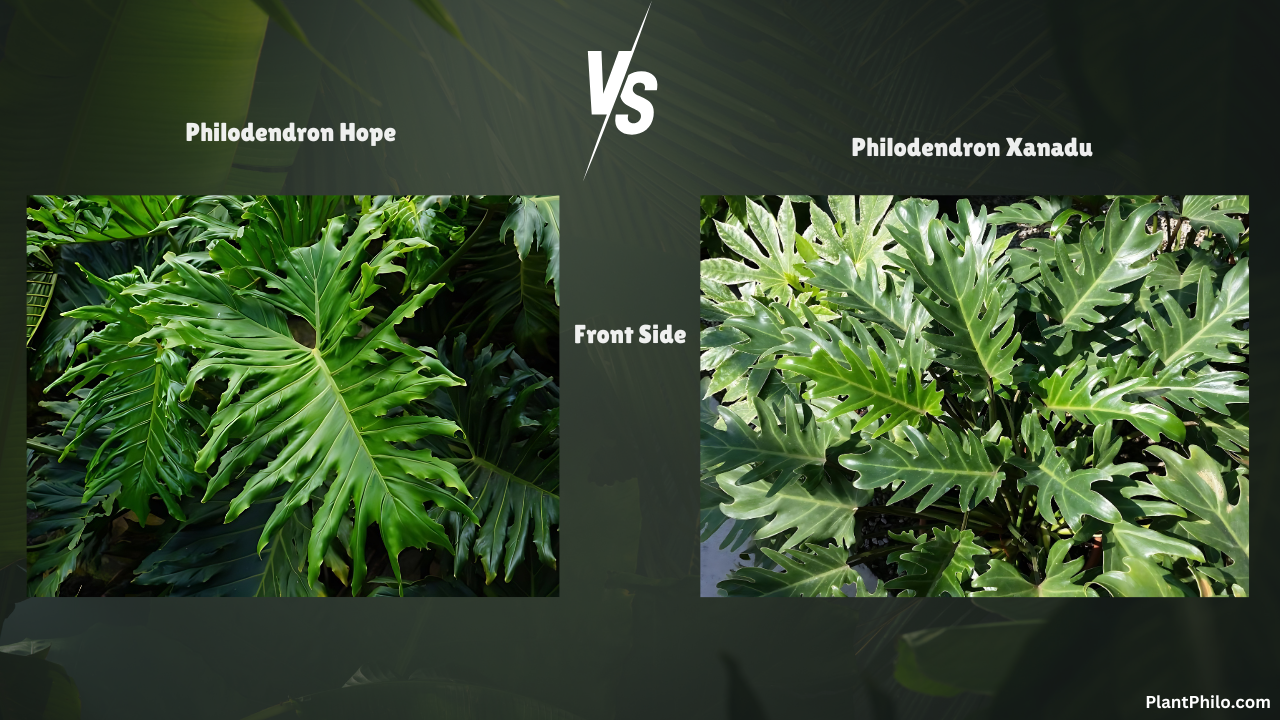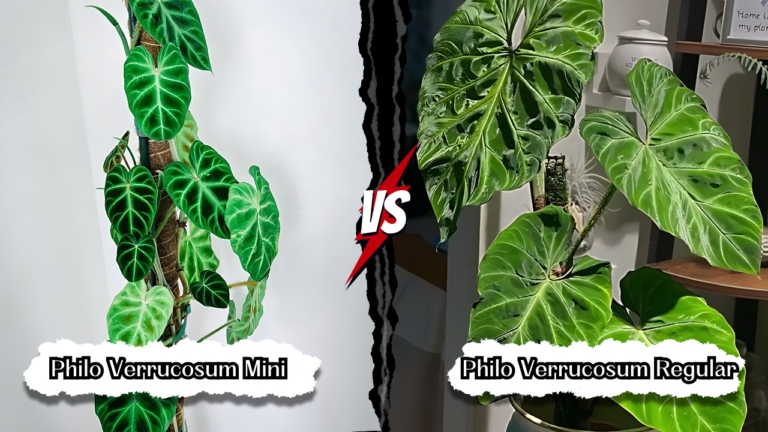Philo Hope vs. Xanadu: Are these the same?
Philodendron Hope and Xanadu are two names that conjure images of lush, tropical foliage and vibrant green spaces. But let’s face it, choosing between these two popular houseplants can feel like navigating a dense jungle. The similarities can be overwhelming, leaving you scratching your head and wondering, “Which one is right for me?” Fear not, fellow plant enthusiast! We’re here to guide you through this verdant labyrinth, shedding light on the unique characteristics and care needs of each plant. By the end of this journey, you’ll be equipped to make an informed choice and bring a touch of paradise into your home without the fear of turning your living room into a tangled mess of vines.
Philodendron Hope vs. Xanadu: Can You Spot the Difference?
At first glance, these two Philodendrons might seem like identical twins, separated at birth in the heart of the rainforest. But look closer, and you’ll start to notice subtle differences that set them apart. Let’s break down their key features side-by-side:
| Feature | Philodendron Hope | Philodendron Xanadu |
| Leaf Shape | Large, deeply lobed with wavy margins | Smaller, deeply lobed with more pointed lobes |
| Leaf Color | Glossy green | Dark green |
| Petiole | Long, green, and smooth | Shorter, green, and smooth |
| Stem | Thick, green, and sturdy | Thick, green, and sturdy |
| New Leaf Color | Light green | Light green |
| Growth Habit | Upright, self-heading | Clumping, spreading |
| Soil | Well-draining potting mix | Well-draining potting mix |
| Temperature | 65-80°F (18-27°C) | 65-80°F (18-27°C) |
| Humidity | Moderate to high (50-70%) | Moderate to high (50-70%) |
| Light | Bright, indirect light | Bright, indirect light |
| Water | Water when the top inch of soil is dry | Water when the top inch of soil is dry |
| Fertilizer | Fertilize monthly during the growing season | Fertilize monthly during the growing season |
| Common Pests & Diseases | Spider mites, mealybugs, scale, root rot | Spider mites, mealybugs, scale, root rot |
| Propagation | Stem cuttings, division | Stem cuttings, division |
| Toxicity | Toxic to pets and humans if ingested | Toxic to pets and humans if ingested |
Beyond the Leaves: Understanding Their Origins and Growth Habits
Just like people, plants are shaped by their origins and growth habits. Knowing where these Philodendrons hail from and how they naturally grow gives us valuable clues about their care preferences.
- Philodendron Hope: This cultivar, also known as Philodendron Selloum ‘Hope,’ is a hybrid variety developed for its compact, self-heading growth habit. It’s a bit of a mystery regarding its exact parentage, but it’s believed to be a cross between Philodendron bipinnatifidum and another unknown species. Its upright growth and large, deeply lobed leaves make it a striking focal point in any room.
- Philodendron Xanadu: This popular houseplant hails from the rainforests of Brazil. It’s known for its clumping, spreading growth habit and deeply lobed leaves that resemble a tropical starburst. In its natural habitat, it thrives in the filtered light of the forest understory, making it well-suited to indoor environments.
Care Tips: Nurturing Your Leafy Companions
Both Hope and Xanadu are relatively low-maintenance plants, but they do have some specific care requirements to keep them looking their best.
- Light: Both plants prefer bright, indirect light. Avoid direct sunlight, which can scorch their leaves. An east- or west-facing window is ideal.
- Water: Water when the top inch of soil is dry. Allow excess water to drain to prevent root rot.
- Soil: A well-draining potting mix is essential for both plants. Look for a mix that contains perlite, coco coir, or orchid bark to ensure proper drainage and aeration.
- Humidity: Both plants appreciate moderate to high humidity (50-70%). You can increase humidity by misting regularly, using a pebble tray, or running a humidifier.
- Temperature: Both plants prefer warm temperatures between 65-80°F. Avoid cold drafts and sudden temperature changes.
- Fertilizer: Fertilize monthly during the growing season (spring and summer) with a balanced liquid fertilizer diluted to half strength.
- Pruning: Prune regularly to maintain shape and encourage new growth. You can also propagate your plants from stem cuttings.
- Pests & Diseases: Keep an eye out for common pests like spider mites, mealybugs, and scale. Treat infestations promptly with insecticidal soap or neem oil. Root rot can be a problem if the soil is kept too wet. Ensure proper drainage and avoid overwatering.
FAQs: Philodendron Hope vs. Xanadu
Which plant is bigger, Hope or Xanadu?
Philodendron Hope tends to grow taller and more upright, while Xanadu has a wider, spreading growth habit.
Can I grow these plants outdoors?
Yes, but only in warm, tropical climates. They are not frost-tolerant.
How often should I repot my Philodendron?
Repot every 1-2 years in the spring or summer when the plant becomes rootbound.
Why are the leaves on my Philodendron turning yellow?
Yellowing leaves can be a sign of overwatering, underwatering, or nutrient deficiencies. Check the soil moisture and adjust your watering accordingly. You may also need to fertilize your plant.
Can I propagate these plants from leaf cuttings?
No, Philodendrons cannot be propagated from leaf cuttings. You’ll need to take stem cuttings with at least one node.
Are these plants toxic to pets?
Yes, both Hope and Xanadu are toxic to pets if ingested. Keep them out of reach of curious cats and dogs.
How do I clean the leaves of my Philodendron?
Gently wipe the leaves with a damp cloth to remove dust and grime. Avoid using harsh chemicals or leaf shine products.
Why is my Philodendron leggy?
Leggy growth is often a sign of insufficient light. Move your plant to a brighter location.
Can I train my Philodendron to climb?
While both plants can be trained to climb, Xanadu is more likely to naturally vine. Provide a moss pole or trellis for support.
Where can I buy Philodendron Hope and Xanadu?
These plants are readily available at most garden centers, nurseries, and online plant retailers.
Choosing Your Green Companion
Choosing between Philodendron Hope and Xanadu ultimately comes down to personal preference and the space you have available. If you’re looking for a tall, statement plant with large, deeply lobed leaves, Hope might be the one for you. If you prefer a wider, spreading plant with a more compact growth habit, Xanadu could be the perfect fit.
No matter which plant you choose, remember that both Hope and Xanadu are beautiful, easy-care houseplants that will bring a touch of the tropics into your home. With a little love and attention, they will thrive and provide you with years of enjoyment.



